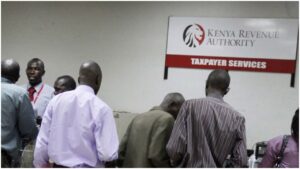Adverse Effects of Climate Change Bedevils Indigenous Groups Even as YWCA Intercedes
By Kenn Osoro
You recognize them with their extremely pale skin, white or yellow hair, sporting reddish, violet, or brown eyes. Along the streets, you will see them wear protective clothes to protect themselves from ultraviolet rays and high temperatures.
The lack of melanin- a skin color pigmentation makes their skin exposed to light rays, which damage skin tumors leading to skin cancer as a result of abnormal skin pigmentation. These are some of the repercussions persons with albinism (PWA) grapple with to encounter adverse effects of climate change.
Climate change adversity has seen them wear sunglasses and other sun protective clothing including hats above their heads to avoid direct sun rays on their skin.
In the realm of development measures on climate change, PWA has been left behind. Be as it may, they decry dying at a tender age due to skin cancer.

“Our life span is shortened by lack of protective lotions and clothing. We die at a very tender age. It is rare to find a person with albinism who is over 70 years old.” Jerita Mutinda, a person with albinism and the chairperson of the Albinism County Network (ACN) in Machakos County revealed.
Her utterance comes amidst speculations and intense debate on the life expectancy of persons with albinism.
Mutinda, who doubles up as a board member of Black Albinism Organization, recounted that their life span ranges ‘between 30-50 years of age.’ This is similar to the United Nations 2023 report which jotted that a majority of persons with albinism die from skin cancer between 30 and 40 years of age.
As a protective measure, the indigenous group applies sunscreen to avert skin cancer-related risks.
“Hardening of the skin due to overexposure to the sun rays makes skin crack. This leads to sunburn.” Mutinda desperately explained while referring to her skin.
This she says might further result in wounds which in turn take a lot of time to heal. In the event the wound heals, it develops growth as a sign of skin cancer.
On her part, cancer-related skin is a major setback and poses a huge challenge to them. She termed it as the ‘number one killer of the people with albinism.’
Increased greenhouse gas emissions into the atmosphere have led to global warming. As a result, intense ultraviolet rays have afflicted persons with albinism. As one of the measures to cushion the condition, they have adopted protective mechanisms, among them the use of protective cloths, lotions, and creams.
The protective lotion cushions them from sunburn and absorbs or reflects UV rays which Mutinda terms ‘the greatest enemy after skin cancer.’
UV rays and high temperatures are two main factors of climate change that affect people with albinism upon exposure.
Wekesa Meshack Seasender, a person with albinism from Trans Nzoia County recalls discrimination he faced in high school.
“We were not allowed to do sciences. Teachers believed that education was all we could do. Our capability is in question. Jobs that are deemed suitable for us include receptionists, customer care, or related jobs.”
Wekesa admits ‘the sun is their greatest enemy’ per se, he added that “a person with albinism is highly prolific to skin cancer due to UV rays. He also presumed presumed protective lotion is expensive.
In a tale portraying profound desperation, Wekesa detailed that the battered economy has made it almost impossible to afford the lotions.
“The government is providing us with Sunscreen lotion worth Ksh. 2500 a bottle. But with the prolonged sunlight, we are using about two bottles a month which goes at Ksh. 5,000.”
Unexpectedly, other than the known lotions, he noted that they also use another lotion coolant every evening. This unique lotion retails at Ksh.1000 at the time this story was published.
Wekesa who attended Milimani Primary School before transiting to Friends School Namanjalala Secondary in Trans Nzoia, said teachers and pupils were distancing themselves from him, calling him pseudonyms and denying him participation in various curriculum activities.
It reached a point where I felt enough was enough, I had to pressure my mother who later transferred me to an integrated school where I met visually impaired colleagues, he narrated.
According to Wekesa, he found the new environment very friendly and was given an equal opportunity to participate in scouting, talent shows, and sports. That is where he discovered his full potential.
A report from the National Cancer Institute of Kenya denoted that cancer is the third leading cause of death after infectious and cardiovascular diseases in Kenya.
This has exerted significant strains on the population raising a lot of questions on health systems in the country.
Similarly, a report from the National Cancer Summit launched in February 2023, by NIC board chairman, Githinji Gitahi, captured a total of 6,778 cancer cases reported from 42 health institutions in 21 counties. These numbers include persons with albinism.
These aggregate figures represent those who have been going through thick and thin to fight the deadly disease.
Skin-related cancer is expensive to treat in Kenya- close to impossible, and those who feel the pinch are patients from remote areas which Mutinda says often lose hope due to the huge expenses they incur on cancer treatment.
Kenya National Commission on Human Rights (KNCHR) appraised data collected during the 2019 Kenya population and housing census. These statistics included specific indications for albinism as a disability domain.
Figures revealed a total of 9,729 persons with albinism in Kenya.
Distribution of persons with albinism put Kakamega as the leading county with 568 closely followed by Meru County with 563 then Nairobi County third placed with 525 cases.
Counties such as Isiolo, Makueni, Marsabit, and Lamu recorded less than 30 cases of persons with albinism.
In the distribution of PWA by sex in the 47 counties, Kakamega County was the highest recording 314 females with albinism, followed by Meru, Bungoma, and Nairobi County respectively. Male persons with albinism were dominant in Meru, Garissa, Kakamega, and Nairobi.
Lamu, Marsabit, Isiolo, Makueni, Samburu, Elgeyo Marakwet, and Laikipia were on the other hand among the counties that recorded the lowest number of persons with albinism in both genders.
Speaking in November Mutinda blamed poverty, lack of proper health care, and expensive skin cancer treatment as major setbacks.
"Some give up on the way. For instance, for radiotherapy, you have to go to Kenyatta Hospital. In rural areas, one spends a huge fare to go for 25 sessions.
She called for the establishment of more NGOs and private sectors to fight for the interest of indigenous groups, especially in remote areas. She also urged the government to take skin cancer-related health services to the grassroots level.
Apart from the above-mentioned protective measures, if you are keen enough you will observe PWA use protective clothes which are long-sleeved and pull-necks for neck cover.
The mode of lotion application, three times a day, is good proof that those languishing in poverty find it difficult to manage the condition.
From a quick check in the pharmacies and shops, a bottle of Sunscreen and After Sun average is Ksh. 2526 and Ksh. 805 respectively.
The government’s effort to provide these necessities through the National Council for People with Disability has been lauded; however, there has been laxity and inconsistency in supplying them to level VI hospitals countrywide.
There is a need for more NGOs and other government parastatals to collectively come up with measures on how to provide more sunscreen lotions to PWA as a way of mitigating climate change effects. County governments to have a budget to cater to PWA.
In case any donations, should be channeled to people who are in remote and slum areas that are languishing in poverty and have a challenge in affording them.
Home-based sensitization and awareness of the protective measures should be a continuous process to enlighten more people with albinism to protect themselves from adverse UV rays, intense heat, high temperatures, and other climate change effects.

More albinism-associated organizations should also be incorporated into government and non-governmental climate change advocacy campaigns.
Young Women Christian Association (YWCA) as one of the non-governmental organizations is on a move to deepen indigenous people's engagement in climate adaptation and mitigation at par.




